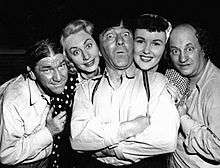Victoria Horne
| Victoria Horne | |
|---|---|
 Victoria Horne (second from left) with the Three Stooges and co-star Patricia Wright (second from right) in Cuckoo on a Choo Choo. | |
| Born |
November 1, 1911 New York City, U.S. |
| Died |
October 10, 2003 (aged 91) Beverly Hills, California, U.S. |
| Resting place | Forest Lawn Memorial Park, Glendale |
| Other names | Victoria Horne Oakie |
| Alma mater | American Academy of Dramatic Arts |
| Occupation | Actress |
| Years active | 1944-1959 |
| Spouse(s) | |
Victoria Horne (November 1, 1911 – October 10, 2003) was an American character actress, appearing in 49 films (uncredited in 25 of these) during the 1940s and 1950s.
Early years
Horne was born on November 1, 1911, in New York City, New York, to Ignatz Hornstein (who emigrated from Braila, Romania) and Mary Louise Schoenwetter Hornstein.[1] She was the second of four children. The family named was changed to "Horne" when she was a child.
She was a graduate of the American Academy of Dramatic Arts.[2]
Career
The films in which she appeared included Blue Skies, The Ghost and Mrs. Muir, and Abbott and Costello Meet the Killer, Boris Karloff. Perhaps her best-known film roles were as Myrtle Mae Simmons in the 1950 film adaptation of Mary Chase's play Harvey, as Roberta in the 1952 Three Stooges short subject Cuckoo on a Choo Choo, and as Nabura, a villainous Japanese agent in the 1945 serial Secret Agent X-9.
Personal
She married actor Jack Oakie in 1950 and remained with him until his death on January 23, 1978. After his death, she arranged the posthumous publication of her late husband's book, Jack Oakie's Double Takes and also published a number of other books about him.
Victoria and Jack Oakie lived their entire married life at "Oakridge", their 11-acre (45,000 m2) estate at 18650 Devonshire Street (just west of Reseda Boulevard) in Northridge, Los Angeles, California. Victoria Oakie continued to live there after her husband's death and bequeathed the estate to the University of Southern California. After two failed attempts to develop the property, Oakridge was acquired by the City of Los Angeles. The city plans to use the property as a park and community event center. Oakridge was originally commissioned by Barbara Stanwyck and designed by Paul Williams, and is considered to be one of the last remnants of the large Northridge estates famed for thoroughbred breeding. The house and grounds are Los Angeles Historic-Cultural Monument #484.[3][4][5]
Death
Horne died on October 10, 2003, in a retirement home in Beverly Hills, California. She was 91.[2]
Legacy
The Jack Oakie and Victoria Horne Oakie Charitable Foundation underwrites "lectures on comedy and scholarships for deserving film and theater students at some of the most prestigious institutions in the country."[6] An official of Syracuse University said that money provided by the foundation "was a godsend" in helping the university establish its semester-in-Los-Angeles program.[7]
Partial filmography
- San Diego, I Love You (1944)
- The Scarlet Claw (1944)
- Secret Agent X-9 (1945 serial)
- The Scarlet Horseman (1946)
- To Each His Own (1946)
- Blue Skies (1946)
- Suddenly, It's Spring (1947)
- The Ghost and Mrs. Muir (1947)
- Abbott and Costello Meet the Killer, Boris Karloff (1949)
- Mary Ryan, Detective (1949)
- The Life of Riley (1949)
- The Good Humor Man (1950)
- Harvey (1950)
- Cuban Fireball (1951)
- Cuckoo on a Choo Choo (1952 short)
- Affair with a Stranger (1953)
References
- ↑ Foote, Lisle (2014). Buster Keaton's Crew: The Team Behind His Silent Films. McFarland. p. 89. ISBN 9780786496839. Retrieved 13 August 2017.
- 1 2 McLellan, Dennis (October 17, 2003). "Victoria H. Oakie, 91; Gave Up Acting Career for Film Comic Husband". Los Angeles Times. Archived from the original on 13 August 2017. Retrieved 13 August 2017.
- ↑ Book description for Jack Oakie's Oakridge at Amazon.com. Accessed June 16, 2007. (This appears to be incorrect; California Historical Landmark #484 is Georgetown, while Oakridge is Los Angeles Historic-Cultural Monument #484.)
- ↑ "City of Los Angeles Acquires Historic Oakridge Estate" (PDF). City of Los Angeles, Department of City Planning, Office of Historic Resources. July 2010. p. 5. Retrieved November 6, 2010.
- ↑ "Historic-Cultural Monument (HCM) List" (PDF). City of Los Angeles, Department of City Planning, Office of Historic Resources. August 9, 2010. Retrieved November 6, 2010.
- ↑ "The Oakie Foundation". Syracuse University: Los Angeles Semester. Syracuse University. Archived from the original on 13 August 2017. Retrieved 13 August 2017.
- ↑ Saval, Malina (July 19, 2017). "Jack Oakie and Victoria Horne Oakie Charitable Foundation Gives Back". Variety. Archived from the original on 13 August 2017. Retrieved 13 August 2017.
Bibliography
- Jack Oakie (1980). Jack Oakie's Double Takes. Strawberry Hill Press. ISBN 0-89407-019-3. Autobiography published posthumously by Oakie's widow on January 1, 1980. 240 pages.
- Victoria Horne Oakie (1980). Jack Oakie's Oakridge. Strawberry Hill Press. ISBN 978-0-89407-102-7. A history of the Oakie family home, "Oakridge". 126 pages.
- Victoria Horne Oakie (1994). "Dear Jack": Hollywood birthday reminiscences to Jack Oakie. Strawberry Hill Press. ISBN 978-0-89407-113-3. Letters of congratulation and reminiscence sent from almost 150 celebrities to Jack Oakie in celebration of his 70th birthday. Compiled & edited by Mrs Oakie to commemorate his 90th birthday. 140 pages.
- Jack Oakie and Victoria Horne Oakie (1997). When the Line Is Straight: Jack Oakie's Comedy in Motion Pictures. Strawberry Hill Press. ISBN 978-0-89407-140-9.
- Victoria Horne Oakie (2001). Life With Jack Oakie: Anecdotes. Strawberry Hill Press. ISBN 0-7862-3417-2.